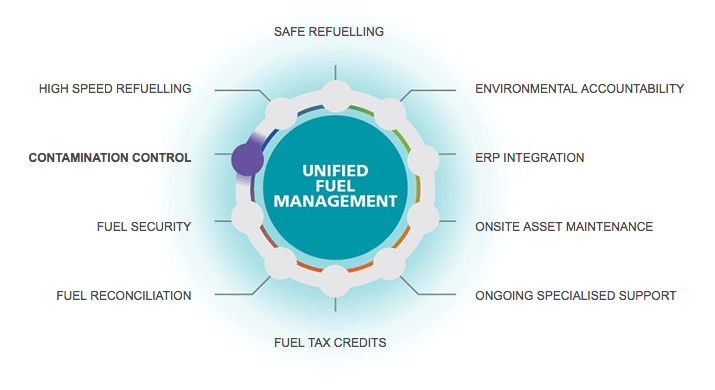Contamination: cleaner fuels and fluids mean increased productivity
Modern engines and plant equipment are designed to offer increased efficiency, reduced emissions and longer service intervals. As a result, they are also more sensitive to fuel and oil contaminants. In particular, higher fuel pressures within engines to achieve a more complete combustion lead to closer tolerances, causing even smaller particles to have an effect on the life and performance of fuel system components.
Modern ULSDs and biodiesels also pose an increased risk of water (moisture) retention and microbial contamination, which left undetected and untreated, can seriously degrade the quality of the fuel, and introduce other problems including reduced fuel filter life and accelerated corrosion of tanks, pipes and other metal components.
Maintaining reduced contamination levels in fuels and other fluids will save you money. You do this by establishing proper monitoring and control measures from the moment the fuel or lube is delivered to your site, until the moment that hydrocarbon is consumed, or removed from your equipment as waste product.
Banlaw contamination control checklist:
-
INWARDS/SUPPLY FILTRATION
Remove particulate matter with appropriate filtration. Assess whether water removal/separation is a viable additional feature.
-
TANK LEVEL MONITORING (TLM)
Select TLM hardware and monitoring software which can identify and issue alarms when water reaches specified levels within your bulk storages.
-
TANK BREATHERS
Install an appropriately rated tank breather (venting) system, incorporating key features such as air filtration, water/moisture removal, filter condition indication, and a pressure/vacuum breather. Moisture and particulate (e.g. dust) ingress into a diesel tank promotes problems such as microbial activity and other fuel degradation.
-
TANK WATER DRAINAGE
Reduce the build-up of sludge and particulate matter in storage tanks by draining off water at regular intervals.
-
STOCK ROTATION
Modern diesel fuels have a “use by date”! Avoid burning aged and potentially damaging fuels by dispensing on a “first in first out” basis. In the event of fuel treatment, quarantine fluids after “dosing” to avoid downstream issues. A mine spec Fuel Management System (FMS) can support these activities, and incorporate Automated Stock Rotation to limit the cost of managing such processes.
-
FUEL PUMPING
Incorporate strainers to maximise pump life by excluding larger contaminant particles.
-
OUTWARDS/DISPENSING FILTRATION
A common myth is that filtration and fuel/fluid treatment systems on-board plant equipment “guarantee” the stringent contamination levels required by engine and fuel system OEM’s. On-board filtration is your “last line of defence” to help ensure fuel and fluids dispensed into machinery meet acceptable contamination levels. BUT, this last line of defence is not infallible, and should be supported by appropriate fluid contamination control further upstream in addition to adequate condition monitoring and servicing of all filtration systems.
-
FLUID DISPENSING POINTS
Fluid cross-contamination can occur when refilling bulk storages as well as fluid dispensing into plant equipment. Are you using the same (common, interchangeable) fluid couplings for more than one fluid type? You’re at risk! Oil, coolant, grease, and fuel contaminants are often introduced by couplings with deep recesses that become laden with mud/ore/etc. Particulate and fluid cross-contamination can be virtually eliminated with a combination of “flush-face” dry-break couplings, where only “paired” nozzles and receivers will connect to transfer a specific fluid type.
-
NOZZLE HOLSTERS
Nozzle Holsters should be incorporated into the total fuel contamination control process. Keeping nozzles clean and off the ground reduces contaminant ingress at dispensing points, but also improves operator ergonomics and increases the life of fuel dispensing hardware.
-
ON-MACHINE TANK BREATHERS
As with bulk fluid storages, the volume of potentially contaminated air entering a tank equals the volume of fuel (or other fluid) dispensed from tanks and other fluid reservoirs on-board plant equipment. For example, a machine which consumes thousands of gallons of diesel between refuellings, draws an equal amount of (dusty) air into the fuel tank. Installing “Ultra-Fine” (≤4µm) Filtered Tank Vents is not only recommended by many major diesel engine OEM’s, but has been proven to significantly increase the life of fuel systems, engine components, and other machine components.
-
PREVENTATIVE MAINTENANCE
Routine fuel and fluid condition monitoring is crucial to achieve any contamination control strategy. Leverage Condition Monitoring practices to indicate when filters should be replaced, to sample and analyse fluids for wear metals, contaminants, and additives, and be prepared to act in the event of a problem with fluid quality.




